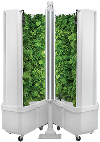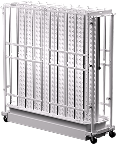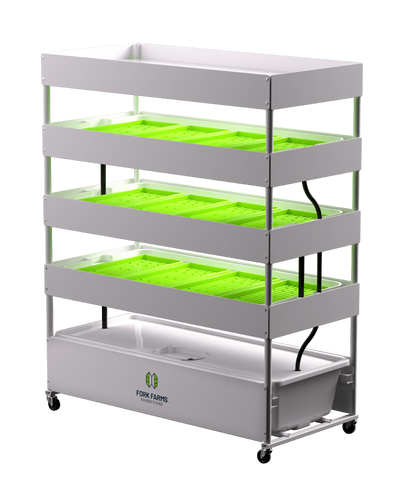Hydroponic Gardens and School Nutrition Programs. How to Introduce More Fresh Greens to More Students
Introducing gardens and hydroponic systems into schools and school nutrition programs is a fantastic way to bring fresh and healthy vegetables, herbs, and some fruits directly to students. The more students know about the benefits of eating fresh greens and the importance of nutrition, the more fresh greens they will consume. Case studies prove that indoor hydroponic growing in schools helps increase children's willingness to try fresh fruits and vegetables because they learn about the foods and are involved in the growing process.
In addition, hydroponics offers hundreds of learning opportunities for students in the areas of STEM, nutrition, agriculture, sustainability, and health. By combining hands-on experimentation in real-world farming scenarios, interdisciplinary learning, and technology, hydroponics provides numerous benefits for students' engagement, critical thinking, and problem-solving skills. More on this can be found in a recent issue of STEM Magazine.
The partners we work with at Fork Farms utilize indoor hydroponic farms and their produce to demonstrate their commitment to healthy menus, sustainability initiatives, nutritional education, and community health. By using hydroponics, schools can ensure a steady supply of produce throughout the year, providing students with fresh food options that are both tasty and nutritious. An article from Served Magazine details how to bring the farm to the school.
Hydroponic farming offers numerous advantages. It uses significantly less water than traditional farming methods and can be set up in areas with limited floor space, allowing schools to grow their own produce on-site. This reduces transportation costs and carbon emissions. For instance, Flex Farms can grow more than 394 pounds of fresh produce annually, using 98 percent less water and 98 percent less electricity than traditional farming. This means better quality food with higher nutritional value is consistently accessible for less than $1.00 per pound.
Returning to the topic of providing more fresh greens to students: once you have secured a hydroponic system for your school (see here for some tips on what to look for when selecting a hydroponic system), follow these steps and strategies to help introduce more fresh hydroponically-grown greens to more students.
Planning and Setup Of Your Hydroponic School Garden:
- Identify a location for the hydroponic garden (i.e. unused locker rooms, classrooms, boiler rooms, a closet, or even simply an extra corner in the school’s cafeteria).
- Follow set-up instructions for your hydroponic garden.
- Select the crops you want to grow. It is best to start with fast-growing, easy-to-grow greens like lettuce, spinach, kale, and herbs. Additionally, you can grow other plants such as tomatoes, cucumbers, beans, and peppers in the Flex Farm.
Integration Of Hydroponics Into School Curriculum:
- Incorporate lesson plans and hands-on activities related to plant biology, nutrition, and sustainable agriculture. The Flex Farm is highly engaging and comes with a comprehensive, tailored K-12 curriculum for teachers and administrators. The curriculum is aligned with Next Generation Science Standards, making it desirable for science teachers to add to the syllabus. A hydroponic farm allows students to observe, experiment, and actively participate in the growth of plants. With the Flex Farm, students can observe and document the entire life cycle of plants, from germination to harvest, within a 30-day grow cycle. This hands-on experience allows students to witness the complexities of plant growth and provides a tangible connection to the fresh food served in their school lunch program.
- Get students involved in the process from start to finish by having them maintain the garden and harvest the greens.
- This is also an opportunity for schools to create a garden club and use the garden as a living lab for experiments.
Incorporate the Fresh Food into School Meals:
- Collaborate with the school cafeteria staff to incorporate fresh greens into meals on the cafeteria line. The produce grown at school can be included in salads, sandwiches, burgers, or as side dishes. Consider adding cilantro to the taco bar or fresh basil to a veggie sandwich or cheese pizza.
- Some fun ideas to try: – use the basil grown in the hydroponic garden as an opportunity to make fresh pesto that can be used on school pizza and in pasta dishes. Students who make the fresh basil can also take some home with them to be incorporated into various dishes in their own homes. Oregano, another herb that can be easily grown in a hydroponic garden, can be used in pasta sauces, sprinkled on pizza, chicken, potatoes, and more. Strawberries,a fruit that can be grown fairly easily in a hydroponic setting, can be used in a spring strawberry salad or as a side fruit dish in schools.
- Check out these resources: Guide to cooking with fresh herbs and the health benefits of fresh herbs — and how to eat them for more creative cooking ideas.
Get Students Cooking:
- In addition to the homemade pesto recipe mentioned above, teachers can host a contest and tasting event for the students where they can grow a variety of fresh greens and vote on their favorite. Students can also take any excess lettuce home to their families to determine what greens the whole family enjoys the most.
- The school can also host a "Green Day" with activities, games, and prizes all centered around fresh greens and healthy eating.
- In cooking or science classes, students can learn how to dehydrate fresh greens into powders, such as lettuce, spinach, or kale. All you’ll need is an oven, and a blender or food processor. There are many ways to enjoy the powder, with one of the easiest being to add it to smoothies for an extra boost of healthy ingredients.
Implement Sustainable Practices Inside School Doors:
- Teach students about composting and sustainable practices, then implement a composting program in the lunchroom. This can be as simple as placing a compost bin and signage in the cafeteria.
- Depending on your location and available resources, you will need to determine the next steps for managing the compost material.
Community Involvement:
- If the school’s hydroponic garden produces excess produce, students can explore opportunities to sell it at local farmers' markets or donate to local food banks.
- Students can also research partnership opportunities with local businesses and organizations to further support their growing program.
- An interesting example is the Fairchild Tropical Botanic Garden's Growing Beyond Earth program in Florida. This classroom-based STEM program involves students growing plants hydroponically and sharing their results with NASA, contributing to research for growing food in space. In its seventh year, the program has engaged more than 40,000 middle and high school students and their teachers across the country, who have contributed hundreds of thousands of data points and tested 200 varieties of edible plants for NASA.
By integrating hydroponic gardens into school nutrition and lunch programs, schools can provide students with reliable access to fresh, nutritious greens while offering valuable educational and real-life experiences. Feel free to reach out if you have any questions about integrating hydroponics into your school nutrition program. We’re here to help.
Important Links:
























